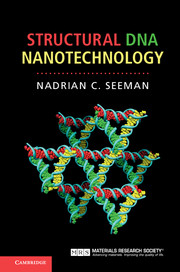Book contents
- Frontmatter
- Contents
- Preface
- 1 The origin of structural DNA nanotechnology
- 2 The design of DNA sequences for branched systems
- 3 Motif design based on reciprocal exchange
- 4 Single-stranded DNA topology and motif design
- 5 Experimental techniques
- 6 A short historical interlude: the search for robust DNA motifs
- 7 Combining DNA motifs into larger multi-component constructs
- 8 DNA nanomechanical devices
- 9 DNA origami and DNA bricks
- 10 Combining structure and motion
- 11 Self-replicating systems
- 12 Computing with DNA
- 13 Not just plain vanilla DNA nanotechnology: other pairings, other backbones
- 14 DNA nanotechnology organizing other materials
- Afterword
- Index
- References
2 - The design of DNA sequences for branched systems
Published online by Cambridge University Press: 05 December 2015
- Frontmatter
- Contents
- Preface
- 1 The origin of structural DNA nanotechnology
- 2 The design of DNA sequences for branched systems
- 3 Motif design based on reciprocal exchange
- 4 Single-stranded DNA topology and motif design
- 5 Experimental techniques
- 6 A short historical interlude: the search for robust DNA motifs
- 7 Combining DNA motifs into larger multi-component constructs
- 8 DNA nanomechanical devices
- 9 DNA origami and DNA bricks
- 10 Combining structure and motion
- 11 Self-replicating systems
- 12 Computing with DNA
- 13 Not just plain vanilla DNA nanotechnology: other pairings, other backbones
- 14 DNA nanotechnology organizing other materials
- Afterword
- Index
- References
Summary
Structural DNA nanotechnology rests on three pillars: (1) nucleic acid hybridization, (2) facile synthesis of designed DNA sequences, and (3) the ability to design branched DNA molecules. This chapter is primarily about the third topic, but before we get into it, we should briefly discuss the other two topics. The hybridization of DNA strands is taken for granted by virtually all investigators today, but this was not always so. When the first hybridization was done in 1956 by Rich and Davies (see Chapter 1), the result was treated with skepticism, typified by the comment, “You mean [the two strands hybridize] without an enzyme?”
The first approaches to DNA nanotechnology entailed sequence design that attempted to minimize sequence symmetry in every way possible. Such sequences are not readily obtained from natural sources, so the synthesis of DNA molecules of arbitrary sequence is a sine qua non for DNA nanotechnology; the field would not exist without the phosphoramidite-based synthesis methodology developed by Caruthers and his colleagues. Fortunately, DNA synthesis has existed for about as long as needed by DNA nanotechnology: synthesis within laboratories or centralized facilities has been around since the 1980s; today it is possible to order all the DNA components needed for DNA nanotechnology, so long as they are free of complex modifications, i.e., so-called “vanilla” DNA. In addition, the biotechnology enterprise has generated demand for many variants on the theme of DNA (e.g., biotinylated molecules), and these molecules are also readily synthesized or purchased.
The details of DNA base pairing. What about branched DNA? All of us know that A pairs with T and G pairs with C. That's how biology works. However, we are not talking about biology here. We are talking about making things out of DNA that do not form readily in biological systems. What problems arise in this case? What can go wrong, and why? Are there simple solutions to the issues that arise? To answer these questions we should examine the structure of DNA in more detail, and talk about the things DNA and its components can do, so as to be sure that we can get it to do what we want it to do.
When we talk about A pairing with T and G pairing with C, we are talking about hydrogen bonded interactions.
- Type
- Chapter
- Information
- Structural DNA Nanotechnology , pp. 11 - 27Publisher: Cambridge University PressPrint publication year: 2016



